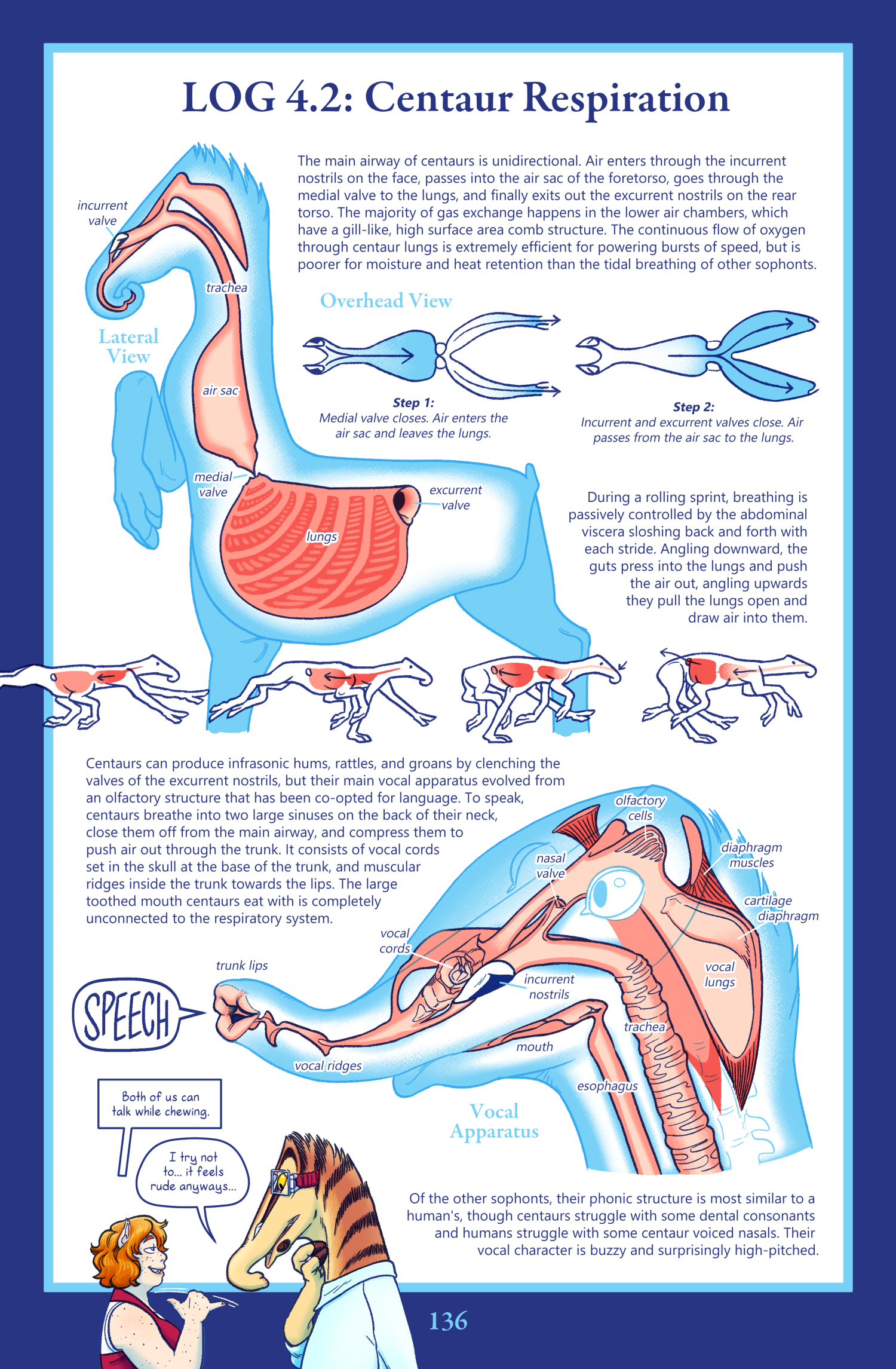This log is about how in the goddamn centaurs breathe and talk. I did animations of this 3 years ago but the anatomy has changed a bit since then. I had to rearrange some pipes in the head. I've been told centaurs look top-heavy while quadrupedal but it's kind of an illusion, since their upper torso is mostly filled with air.
Final reminder to submit any new character questions here for the upcoming AMA.
Transcript
LOG 4.2: Centaur Respiration
The main airway of centaurs is unidirectional. Air enters through the incurrent nostrils on the face, passes into the air sac of the foretorso, goes through the medial valve to the lungs, and finally exits out the excurrent nostrils on the rear torso. The majority of gas exchange happens in the lower air chambers, which have a gill-like, high surface area comb structure. The continuous flow of oxygen through centaur lungs is extremely efficient for powering bursts of speed, but is poorer for moisture and heat retention than the tidal breathing of other sophonts.
Overhead View
Step 1: Medial valve closes. Air enters the air sac and leaves the lungs.
Step 2: Incurrent and excurrent valves close. Air passes from the air sac to the lungs.
Lateral View
-
incurrent valve
-
trachea
-
air sac
-
medial valve
-
lungs
-
excurrent valve
During a rolling sprint, breathing is passively controlled by the abdominal viscera sloshing back and forth with each stride. Angling downward, the guts press into the lungs and push the air out, angling upwards they pull the lungs open and draw air into them.
A running sequence shows a centaur in a hexapodal gallop with synchronized breathing.
Vocal Apparatus
SPEECH is shown emerging from the trunk lips.
-
trunk lips
-
vocal ridges
-
vocal cords
-
incurrent nostrils
-
nasal valve
-
olfactory cells
-
diaphragm muscles
-
cartilage diaphragm
-
vocal lungs
-
mouth
-
esophagus
-
trachea
Centaurs can produce infrasonic hums, rattles, and groans by clenching the valves of the excurrent nostrils, but their main vocal apparatus evolved from an olfactory structure that has been co-opted for language. To speak, centaurs breathe into two large sinuses on the back of their neck, close them off from the main airway, and compress them to push air out through the trunk. It consists of vocal cords set in the skull at the base of the trunk, and muscular ridges inside the trunk towards the lips. The large toothed mouth centaurs eat with is completely unconnected to the respiratory system.
Of the other sophonts, their phonic structure is most similar to a human's, though centaurs struggle with some dental consonants and humans struggle with some centaur voiced nasals. Their vocal character is buzzy and surprisingly high-pitched.
Gillie: (ASL) Both of us can talk while chewing.
Talita: I try not to... it feels rude anyways…
Gillie is grinning smugly. Talita clutches her throat nervously.








66 thoughts on “Runaway to the Stars: Page 136”
Hilarious Selkra
You could insult a centaur’s intelligence by claiming their head is full of hot air and it would only be slightly more accurate than if the insult was directed at a human.
HeadWood
Now I’m thinking about an in-universe visual gag on some animated show where a centuar chokes on their food/drink in suprise and gets weird looks for it because that’s nearly impossible (I expect something odd caught at the right angle may choke them in a similar way to wringing someone’s neck from the outside, but that’s an edge case that I suspect would not make its way into urban legend/popular culture when “centaurs can’t choke” is much simpler.).
ryttyr
Wait… but why does she curve her trunk towards herself when talking then? Wouldn’t that be equivalent to turning your head away when talking to someone in terms of sound?
Rad Internet Stranger
SPEECH
eden5457
Quick question- how does she pronounce sounds like t, n and s, without a tongue?
TotallySomebody
This AMA!
https://www.runawaytothestars.com/comic/rtts-reader-questions-5/
TotallySomebody
Or I guess it was a QnA oops!
JoB
Jay (on page 134): “Can you guess how the title was thematically relevant?”
·
… “Now I’m gonna have to destroy you”? 8-S
https://politeandgood.com/comic/71
JoB
“Both of us can talk while chewing.”
·
… ah, so that counts, Gillie?
[types this while emptying a glass of gherkins]
Sen
I love these kinds of details. It feels like being a researcher exploring another planet.
Felgraf
Reading your comic, and these asides that go into the detail of various species, etc—
It gives me the same feeling reading Dinotopia did as a kid. (I mean this with and as the highest possible praise!)
Ruby
You know what I’m curious about? Centaur singing.
I mean, I imagine that it’s fairly similar to human singing. But just thinking about the subtle differences makes me imagine how vast the variety can be.
Also, I had the thought of Talita sounding like Lois Griffin and now it haunts me. 💀
malmo
Centaurs can sing with a drone accompaniment and I’m jealous
Hubert
Ooh, I want centaur bagpipes.
Ruby
Would centaurs play air instruments with their exhaling valves or with their trunk? 🤔
creetur
Trunk, probably. I remember Jay made a post on their Tumblr about centaur glass blowing (among other things) and it used the trunk, not the exhaling valves.
malmo
but consider: both at once
JoB
……. centaurs *playing* standard bagpipes, or centaurs – with their ability to exhale through up to four orifices – grabbing four pipes to make one out of *themselves*?
Dove
Talita sounds like Kimiko Glenn confirmed
TotallySomebody
AAHHAHHAHA (the only role I know them from is as a horse 💀)
Teod
Kind of a morbid question, but can centaurs uhh… survive decapitation? Their brain is in the torso and so are lungs. I guess they’d have a lot of immediate trouble breathing due to absence of intske valve (on top of the inevitable bleeding), but I’m not certain just how bad it would be.
furubatsu
There is a character on the Centaur home planet that’s missing 1/3 of her head (It got stepped on as a small child and crushed) and speaks with an impdeiment but otherwise seems fine.
Jay Eaton’s response is: get asked a lot if centaurs can survive decapitation, since their brain is in their midchest. The answer is…. not very well. The traumatic blood loss and nerve shock of a severed neck is normally pretty damn fatal. They are, however, much more capable of surviving head injuries that would kill an animal from Earth. This lady got stomped by a five ton livestock animal when she was a girl, shattering a quarter of her skull and taking out her right eye, ear, and speech sinus.
She remains imposing as ever, though.
RandomGermanNumber5
Do you have a link to this? I am really curious what she looks like.
Zidane
here she is! https://jayrockin.tumblr.com/post/655550323873742848/matriarch-with-a-broken-crown-i-get-asked-a-lot#notes
Vinemaple
When I first had this realization, I immediately thought of Mike the Headless Chicken: https://en.wikipedia.org/wiki/Mike_the_Headless_Chicken
I’m glad that Centaur decapitation is usually fatal, because the idea of a sophont going through what Mike went through seems like a Fate Worse Than Death. So, my follow-up question is, are Centaur brains actually better protected than Human brains, behind a whole lot of muscle as well as a skull? Or does it somehow wind up being about the same?
SheTheTDE
Centaurs and my alien alter-ego have a lot in comon. I probably have just as much in comon with scuds and bug-ferrets. I’m a very weird spac-flower.
Boxthing
I am suuuuper jealous that centaurs never have to worry about food going down the wrong pipe.
Vinemaple
I don’t think I will ever be able to design alien species to this level of detail and consistency. It’s glorious and I revel in it. FYI, there is a lot more of Jay’s spec bio online if you know where to look.
Divergent Species
That’s the attitude of a quitter. There is no such thing as a talent you cannot learn. You just need to set your mind to it.
fen
a talent you can learn is called a skill
the Inmara
Neurodiversity does affect how well different people can learn different things.
Not everyone is capable of doing math well, for instance. There is such thing as dyscaclulia. Same with reading, with dyslexia. Same with walking and swallowing food, with dyspraxia. Etc.
Some people are just not well suited to learning how to imagine and develop xenobiology as well as Jay does. It’s not being a quitter to recognize that in yourself. But, it’s still worth trying for the fun of just doing it. Where you fall short of someone else’s capabilities is where your own character shows through, in whatever work you’re doing, and that makes it valuable in and of itself.
Also, you can’t learn what your capabilities truly are until you try.
But if it’s not fun to do, if it hurts to push yourself into a new hobby, moving on, doing something else, and admiring those who do it well is totally fine.
Vinemaple
Oh, RTTS is making me think harder than ever about a bunch of newer silly aliens, the biology of which I have barely a clue. It’s all still rather derivative, but fitting well into a “Humans as semi-pariah species in Galactic society” concept I had lying around. Plus I get to fantasize about having as much space to myself as Talita does on Dirtball.
cinna
Man, I love spec bio. I’ve always really admired the thought you put into all these aspects of alien anatomy! I’ve been thinking recently about how we have four nostrils; the excurrent nostrils of bony fish just kinda moved inside the mouth at some point before tetrapods emerged. I think all these little quirks of anatomy and evolution make it so interesting to think about how analagous bodily systems could work. Your solutions are some of the most satisfying to me!
40
Man this comment got me down a massive rabbit hole about nostrils and lungs and stuff. This shit’s so interesting.
Correct me if any of this is wrong but; nostrils only used to be an olfactory structure and lungs (which also existed way before fish crawled onto land) could only be breathed-through via the mouth. The problem with that is it’s really easy for you to block your lungs and choke (it wouldn’t fully kill you, you still had gills, but it would be a pain in the ass), but the fish that had their olfactory outputs lead into their mouth now had 2 backups to breath through.
Oodles
Can centaurs breathe and speak at the same time? The nasal valve is above the trachea so i assume so. Every few breaths would have to be pushed into the sinus but otherwise talking would never wind them.
Oodles
Talking may stop them from being able to SMELL though
Jay Eaton
Correct!
Jay Eaton
Yes. A centaur could be exhausted from exertion and wheezing for air but have relatively unaffected speech.
AnormalADN
Oh I’m noticing, centaurs still have at least one foot on the ground while running at full speed, would that be because they’re too heavy? Would it be tough on their leg joints to jump a lot?
Martin
I dont think theres one foot on the ground in the very first one?
eden
the page that had talita running on the treadmill has a very cool animation of the centuar run cycle in the post below it! they fo have one foot on the ground at all times, it looks like this one was just cropped out.
eden
aaaaaand I just looked at it and realised I have a goldfish brain. sorry!
Apollo235
Can Centaurs inhale through the trunk since it’s an olfactory structure?
Also looking at it here, the distance between the vocal chords and trunk-lips seems to be quite comparable to the distance between a humans vocal chords and mouth, so presumably the lack of sinuses is the thing that makes Centaurs higher pitched?
Jay Eaton
Yeah, they can sniff through the trunk. And also refill the vocal lungs or breathe through it, though the latter would be a bit like a human trying to breathe through a single nostril. Unpleasantly inefficient.
Centaurs are higher pitched because they have smaller vocal chords, less resonant area downwind of the vocal cords than a human pharynx and nasal cavity, and smaller lung capacity/lower airflow than a human. Their setup is more of a piccolo than a clarinet.
Apollo235
> like a human trying to breathe through a single nostril.
With my allergies that’s just normal operation! (I get what you mean though)
JoB
If doing it *unintentionally* counts, add pretty much *everyone* (… in our pre-First-Contact world) to the list. :-3
https://en.wikipedia.org/wiki/Nasal_cycle
Zuorai
My name is Talita. I rebuilt the Runaway. It was difficult to put the pieces together
gooeymander
My name is Gillie. Bip. I want zucchini. Gillie that is my name. Gillie I want another. Gillie
Napkinkat
How do centaurs clear their lungs? Humans cough and hack phlegm up and swallow it when the king mucus gets icky. What’s the centaur equivalent of coughing?
Claire
Pneumonia resulting in leaky sides sounds profoundly unpleasant. Not that our pneumonia is good, really…
TotallySomebody
Ooagh… YUCK!
Michi
And now remember that there are several species with their heads just level with a Centaur’s exhaust nostrils. I don’t want to imagine what a good sneeze does either.
JoB
Don’t carry an umbrella unless you’re Mary Poppins …
Napkinkat
Imagine the sound of them blowing their side nostrils lol
Jay Eaton
Centaurs can cough and sneeze. It involves clenching the medial valve and contracting the entire airway, expelling air and sometimes goop from both ends. Yucky!
Napkinkat
That sounds very unpleasant, glad I don’t have their lung setup.
eden
does the congestion affect their speech at all? if they have too much goop in their trunks do they slur or have bubble popping sounds?
Jay Eaton
Yes, although unlike in human sinus congestion, thick congestive gunk clogging the trunk or incurrent nostrils is usually a sign of severe infection in the head. Mild respiratory illness for centaurs mostly results in watery discharge from the rear nostrils.
Greebus
This is awesome!
Lilac
Ohhh the centaurs will get various more specific logs….. I see……..
apprenticeNerd
Oh man, now my feral linguist brain is wondering what centaur points of articulation are like! Manners of articulation are probably pretty similar (only so many ways to block air from going through a tube or two), but the points must be totally different. And what would you even call them in English??
40
The trunks are so vastly different and the ridges only exist for speech so I imagine they’d just use the same terms. Or maybe instead like “pseudo-dental” or “pseudo-velar”. Pre-contact Centaur linguists tho?, shit maybe they’d just number them, or describe them like vowels.
K
Can the vocal lung absorb oxygen, or is it really only used for redirecting air for speech?
Ossumsauce
Since it says theyre sinuses I assumed theyre there for making mucus and humidifying the air :]
JoB
Hmmm, they *are* called “lungs”, as opposed to the “air sac” in the upper torso, so …
·
Unless the blood vessels running to the head turn out to be surprisingly large, however, they should be but a *supplement* to the main lungs’ supply. (We know that Talita just continues to exhale out of her excurrent nostrils even when they’re under water, so there’s no need for a head-end-only “emergency breathing mode” for centaurs who accidentally fell into a lake.)
Jay Eaton
It can do gas exchange, since it is a mucus membrane with blood vessels in it, but not to a especially meaningful degree. It is mostly an olfactory organ that got greatly expanded to use for vocalization.